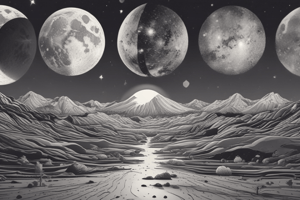Podcast
Questions and Answers
What is unique about the Moon's rotation?
What is unique about the Moon's rotation?
- It is synchronized with Earth's rotation. (correct)
- It is irregular and unpredictable.
- It is extremely slow.
- It is extremely fast.
What is the approximate average distance from Earth to the Moon?
What is the approximate average distance from Earth to the Moon?
- 238,900 miles (correct)
- 400,000 miles
- 100,000 miles
- 300,000 miles
What is the effect of the Moon on Earth's axis?
What is the effect of the Moon on Earth's axis?
- It increases the planet's wobble.
- It has no effect on the planet's axis.
- It causes the planet's axis to shift drastically.
- It moderates the planet's wobble. (correct)
What is the mass of the Moon relative to the Earth's mass?
What is the mass of the Moon relative to the Earth's mass?
What is the term for the Moon's atmosphere?
What is the term for the Moon's atmosphere?
What is the primary theory for the Moon's formation?
What is the primary theory for the Moon's formation?
What is the composition of the lunar regolith?
What is the composition of the lunar regolith?
What is the largest feature on the Moon's surface?
What is the largest feature on the Moon's surface?
How high did the vaporized material from the Earth rise after the giant impact?
How high did the vaporized material from the Earth rise after the giant impact?
What is the Moon's role in making Earth more livable?
What is the Moon's role in making Earth more livable?
Flashcards are hidden until you start studying
Study Notes
The Moon: A Fascinating Companion to Earth
The Moon, our Earth's only natural satellite, is a fascinating celestial body that has captivated humans for millennia. It is the brightest and largest object in our night sky, and it plays a crucial role in making Earth a more livable planet. In this article, we will explore various aspects of the Moon, from its formation to its geology, and its impact on our planet.
Formation of the Moon
According to the "giant impact" theory, the young Earth had no moon. Around 4.5 billion years ago, a rogue planet, larger than Mars, struck the Earth in a great, glancing blow. The impact vaporized most of the rogue body and a sizable chunk of Earth. The vaporized material rose to above 13,700 miles (22,000 kilometers) altitude, where it condensed into innumerable solid particles that orbited the Earth as they aggregated into ever larger moonlets, which eventually combined to form the moon.
Geology of the Moon
The Moon's surface is covered in impact craters, ranging from huge boulders to powdery dust. The largest craters, such as Tycho Crater, are more than 52 miles (85 kilometers) wide. Over billions of years, these impacts have ground up the surface of the Moon into fragments ranging from huge boulders to powder. Nearly the entire Moon is covered by a rubble pile of charcoal-gray, powdery dust, and rocky debris called the lunar regolith.
The Moon has a very thin and tenuous atmosphere called an exosphere. It is not breathable. The Moon has no moons and no rings.
Impact of the Moon on Earth
The Moon plays a significant role in moderating Earth's wobble on its axis, leading to a relatively stable climate. It also causes tides, creating a rhythm that has guided humans for thousands of years.
The Moon's Rotation and Phases
The Moon's rotation is synchronized in a way that causes it to show the same face to Earth at all times. This means we only see one side of the Moon, which is why we call it the "dark side." However, one hemisphere always faces us, while the other always faces away.
The Moon's Orbit and Distance from Earth
The Moon's average distance from Earth is about 238,900 miles (385,000 kilometers). The diameter of the Moon is 2,160 miles (3,476 kilometers). The Moon's mass is about one-eightieth of the Earth's mass.
In Conclusion
The Moon is a fascinating celestial body that has a profound impact on Earth. Its formation, geology, and impact on our planet continue to be the subject of scientific research. As we continue to explore the Moon and learn more about it, we will undoubtedly uncover new insights and discoveries that will further deepen our understanding of this fascinating companion to our planet.
Studying That Suits You
Use AI to generate personalized quizzes and flashcards to suit your learning preferences.




